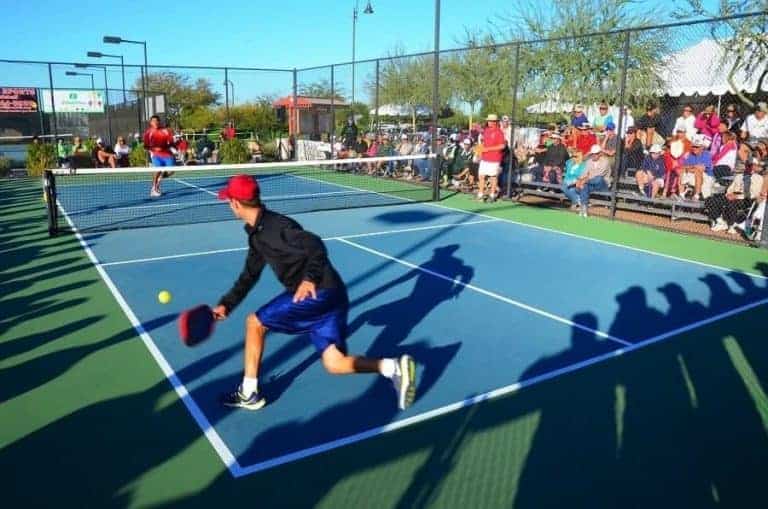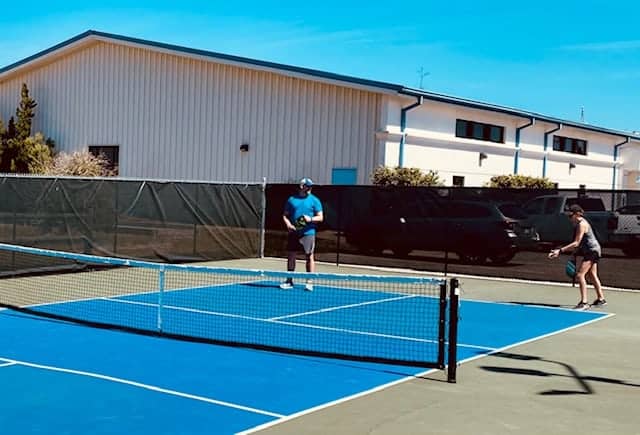What Is A Let In Pickleball? Learn Why The Rule Changed.
Pickleball is becoming more popular every year, likely because it’s a fun, fast-paced sport that you can play almost anywhere with any skill set! Like other racquet sports, pickleball has quite a few rules that you need to learn as you build your expertise. One of those rules is called a “let.”
A let in pickleball used to be when a serve hit the net but still landed properly beyond the no-volley zone line. However, in 2021 the “let rule” in pickleball was removed completely to preserve the integrity of the game. Now, there is no let in pickleball whatsoever.
Starting in 2021, when a serve hits the net but lands properly in your opponents side of the court beyond the no-volley zone line, it is a live ball and played off the net without stopping play. If the serve hits the net and does’t make it over or beyond the kitchen line, it is a loss of serve for the serving team.
While pickleball rules are generally pretty easy to understand, some rules can be a bit confusing. If you’ve ever wondered what the let is, you’re in the right place. This article will go over everything you need to know about lets, including an important update to this rule.
For more on the 5 most common rules in the game of pickleball, click here.
Let Serve In Pickleball – An Overview
In most cases, there’s only one serve attempt allowed in pickleball. However, there’s one exception to this rule: a let serve. Although a let doesn’t count as a legal service, it’s not counted against you either!
For a serve in pickleball to be considered a let, it must:
- Hit the net
- Go over the net
- Bounce in the correct area of the opponent’s court (outside of the no volley zone)
When a let happens, you can simply replay the serve. While there aren’t any limits to lets in a game of pickleball, they tend to be flukes, and you won’t see too many per game.
Click here to learn how a fault is different than let.
Why Is It Called a Let Serve? Where Did The Term Come From?
A few theories exist about where the term “let” came from, although nobody knows for sure. One widespread theory, not backed by evidence, is that it’s a shortened version of “let’s try that again” or “letting” your opponent try the serve again.
While this may be the case, three more theories hold a bit more water.
As you already know, pickleball shares several components with other sports, specifically tennis, badminton, and table tennis. Naturally, one of the most likely theories is that pickleball borrowed the term “let” directly from tennis.
However, another “let” theory is that it stems from the French word “filet,” which translates to “net.” Many assume that tennis players in the United Kingdom picked up this French word, eventually shortening it to a simpler “let.”
The final theory is that the word’s roots date back to the ancient Germanic language, Old Saxon. More specifically, the term “Lettian” translates to “to hinder” in English.
Regardless of the theory, one thing is sure, “a let serve” in pickleball is now a completely different rule compared to a let serve in tennis.
While we may never know exactly where this term originates, it’s fun to theorize what this sport’s creators were thinking when they developed it.
Related Helpful Info: Looking to get better at pickleball? For the most complete guide on simple pickleball strategies designed for beginners, click here.

Pickleball Terms Like “Let”
There are specific criteria for a serve to be a let. However, there is an additional related term worth pointing out: “service faults.”
Service faults in pickleball are any action that breaks the rules during serving that forces gameplay to stop playing. Any type of fault, service faults included, result in a loss of service for the team that committed the fault.
The following list includes ways that a player might receive a service fault, but it’s important to note that these actions don’t equal a let serve:
- If the ball hits the net and lands outside of the service area
- If the ball hits the net and does not go over, landing on the server’s side of the court
Keep in mind that this isn’t a comprehensive list of service faults. However, these specific scenarios are easily mistaken as a service let.
Click here for my helpful beginners guide on what is pickleball so you can learn the nuances of the game and why it’s so popular these days.
Recent Changes To The Let Rule
As with any sport, there’s a governing body that makes decisions regarding different aspects of the game. USA Pickleball — the official organization regulating pickleball in America — recently made an official rule change that affects the “let.”
As of January 2021, USA Pickleball removed all rules that govern let serves, officially taking them out of the rulebooks. This will undoubtedly upset some long-time players of the game, but unfortunately, we don’t have a say in the matter, as it’s already happened.
In the explanation of the new rule, or lack thereof, USA Pickleball Director of Officiating explains that, if you or a teammate stops play because of a let call, despite whether it’s accidental or not, that will result in an automatic fault for that player and/or team.
While they acknowledge that some players might call a play innocently or out of habit, there is unfortunately no wiggle room on whether that player receives a fault. The governing body must draw the line.
Related: Ever wonder how the game got its name? You won’t believe the controversy surrounding pickleball’s name
Why Did the USA Rules Committee Change the Rule?
You might be wondering why they made such a significant rule change, as lets are such a large part of pickleball and any racquet sport.
While I can’t speak directly to this rule overhaul, USA Pickleball revealed three primary considerations for rule changes (in general). In order of priority, the Rules Committee considers the following when making any rule changes in pickleball:
- Preserving the integrity of pickleball
- What’s best for the players (rule changes should improve players’ experience or make it easier to learn the game)
- What’s best for officials (minimize conflict between players and referees)
The USA Pickleball committee considered all of these priorities when making the decision to eliminate lets from the rulebook. They also elaborated on how each of these priorities was considered as they made their decision.
Many of the explanations revolved around the ambiguity of making a let call for both players and officials.

Preserving The Integrity of Pickleball
Maintaining integrity of the game is the Rules Committee’s number one priority when making decisions.
When considering the integrity of the game, the Rules Committee explained that the let rule left a loophole for cheating, whether accidental or not. Nothing can ruin the integrity and fun of a well-loved sport as much as cheating.
There is one main scenario in which the integrity of the game is put at risk because of let calls. Let’s walk through this scenario…
Pretend you have been working and training hard to make it to a national tournament. You are so close, but the game you are playing is not quite advanced enough to require referees.
You serve the ball perfectly and your opponent immediately calls a let serve.
Even though you know it wasn’t a let, there isn’t anything you can do about it. Your opponent may have thought it was a let, but he or she could also be making the call to mess up your game.
Eliminating the let all together will ensure inaccurate calls like this hypothetical scenario are completely avoided, thus preserving the integrity of the game.
What’s Best For The Players?
When considering the players’ experience, the Rules Committee felt that this rule left too much room for conflict between players. If there’s one thing that will ruin a player’s experience, it’s arguing with their opponent about where the ball landed or whether or not it hit the net.
If you use the example from above, that scenario is begging for conflict between players, potentially ruining the game for everyone.
The Rules Committee’s second priority is doing what is best for players, and leaving this space for conflict is certainly not best for them.
What’s Best For Officials?
The Rules Committee also considered the experience of the offials or referees in regard to the let serve. Arguments between officials and players are not uncommon. T
The risks of a referee not detecting a let serve are too high, which causes issues and puts the game’s integrity in danger.
Overall, there’s too much room for inconsistency among referees. So, the decisions to remove lets in the game removed this inconsistency all together.
What Is A Let In Pickleball – Final Thoughts
If you’re playing pickleball in 2021, the let serve rule will no longer apply to your games. For new players, the change to the let rule might not have much of an impact on their pickleball experience.
Regardless of your opinion on the rule change, understanding the let serve and reasons behind the change will make you a more well-rounded pickleball player.
Similar rules still apply in tennis and table tennis so, much of this information is still very relevant.
Enjoy the game and share with us your thoughts on this rule change around lets and serving. Do you think it’s helped the game? Have you had to explain the new rule during a match?
Let us know in the comments sections below, we’d love to hear from you and it make our pickleball community better!

Welcome to TheVolleyLlama.com. My name is Keith, I’m just a lover of all sports that involve a racquet, net and a ball. I played competitive high school varsity tennis, love racquetball and my whole family plays pickleball regularly. I started this website to help give people like you the basics to learn these wonderful games.


